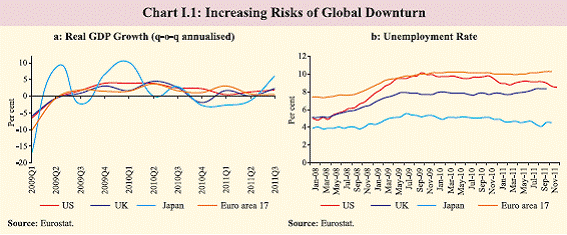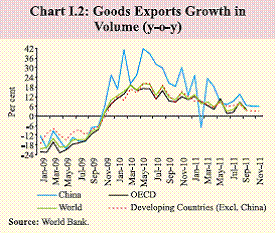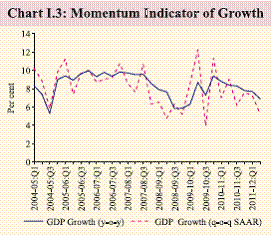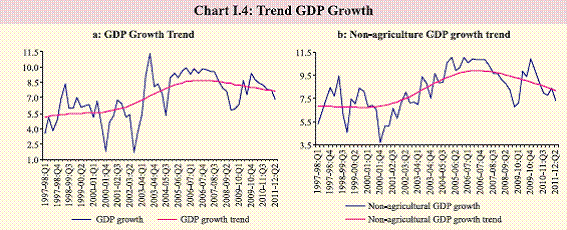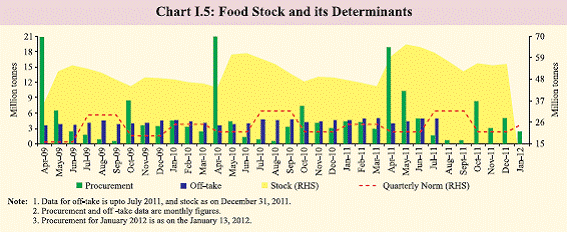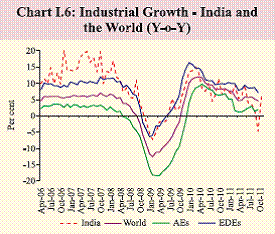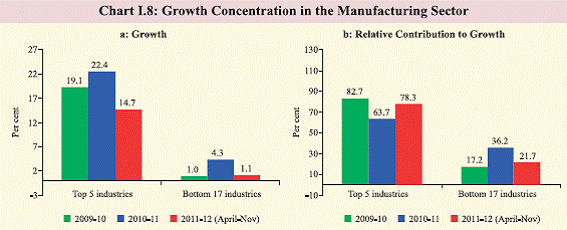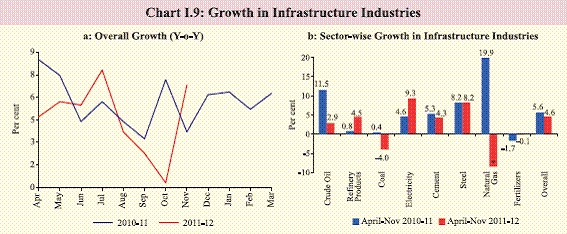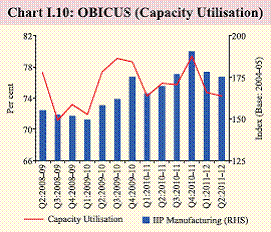I. Output - RBI - Reserve Bank of India
I. Output
The global economy seems headed for another downturn after just three years. While parts of euro area are headed for a recession, slowdown is evident in most other advanced economies as well as emerging and developing economies. There has been a slowdown in growth in India as well given the external conditions, dampened investment demand and high inflation. While agriculture is so far the least impacted sector, the secondary and tertiary sectors have been underperforming. Deceleration in mining and construction sectors that have extensive forward linkages, continued volatility in production of capital goods and slowing activity in some services are of significant concern. Global growth headed for downturn again as recession risks mount in euro area I.1 Fiscal and financial uncertainty in the euro area and the slower recovery in the advanced economies (AEs) have compounded the risks of a sharp downturn in the global economy, with risk of a deep and prolonged recession in the euro area. GDP growth rates in Q3 of 2011 in the major AEs were stagnant or improved only marginally (Chart I.1a). The US economy grew at an annualised rate of 1.8 per cent (revised downwards from the earlier estimate of 2.0 per cent and first estimate of 2.5 per cent) in Q3 of 2011. Japan, though, showed some post- Tsunami recovery and grew at an annualised rate of 6.0 per cent in Q3, as against a decline of 1.3 per cent in Q2 of 2011. During Q3 of 2011, euro area GDP grew by 0.5 per cent quarter-on-quarter. Italy contracted, while Spain recorded zero growth.
I.2 Unemployment rates in the AEs have persistently remained at high levels, though there was some improvement in the US where the unemployment rate dropped to a two and half year low of 8.5 per cent in December 2011 (Chart I.1b). Unemployment rate in the euro area is presently in double digits. With the sovereign debt crisis forcing several European countries to implement tough fiscal policies, risks of further worsening of the economic cycle in the region get accentuated. I.3 Reflecting the knock on effects of the contagion to the emerging and developing economies (EDEs) China’s growth decelerated for the third consecutive quarter in 2011 to 9.1 per cent in Q3 (y-o-y), the lowest in more than two years. Brazil’s GDP growth decelerated to 2.1 per cent in Q3, compared with 3.3 per cent in Q2. Cooling emerging markets’ growth may further dampen India’s external demand I.4 EDEs, which were relatively insulated from the global slowdown during H1 of 2011, are now being subject to the effects of reduced external demand as AEs’ export markets slump (Chart I.2). Chinese export growth decelerated to 13.8 per cent in November, with the overall trade surplus declining 35 per cent over November 2010. A credit crunch as a result of worsening of the euro area sovereign debt crisis could have implications for global trade as trade finance may dry up, causing trade volumes to fall more steeply. India has witnessed a slowdown in export growth in Q4 of 2011 in the wake of cooling external demand. Merchandise exports grew less than 4 per cent in November 2011.
Growth moderation in India significant I.5 Growth in India is moderating on account of large linkages of the manufacturing sector with global demand, investment uncertainty and high interest rates. GDP growth moderated for the sixth consecutive quarter to 6.9 per cent in Q2 of 2011-12, the lowest growth in the last nine quarters (Table I.1). Momentum indicators, as reflected by the q-o-q seasonally adjusted annual growth rate (SAAR), have also shown a decline since Q4 of 2009-10 (Chart I.3).
I.6 The deceleration in GDP growth in H1 of 2011-12 to 7.3 per cent from 8.6 per cent in the previous year was driven by a decline in ‘mining and quarrying’ and sharp moderation in manufacturing sector growth, even as ‘electricity, gas and water supply’ continued to gain momentum. The services sector also moderated, with the slack evident mainly in construction and ‘community social and personal services’. The growth rate of the agriculture sector, however, remained steady during H1 of 2011-12. I.7 The slack in both industrial and services sectors is partly reflective of the inter-linkages between the two sectors. However, in a downturn the services growth is likely to show resilience relative to the industrial growth.
I.8 On the whole, the growth rate of GDP remained below trend in H1 of 2011-12 (Chart I.4). The trend growth rate, which was estimated around 8.5 per cent on an average during 2005-06 to 2007-08, has dipped gradually thereafter and is presently about 8.0 per cent, indicating a structural decline in growth rate of the economy vis-a-vis 2005-08. I.9 The downside risks to growth in 2011-12 and the next year emanate from the possible recession in the euro area, deceleration in export growth in recent months, the lagged impact of weak investment activity and uncertainty with regard to availability of crucial inputs such as coal.
Impact of dismal north-east monsoon limited, agriculture growth likely to stay around trend I.10 As per the First Advance Estimates for kharif 2011-12, production of foodgrains, oilseeds, and other commercial crops, barring pulses, was higher than the kharif output in 2010-11. This is significant given the record production of these crops in the previous year. In the final analysis, the performance of rabi crops will determine the overall outcome for the agriculture sector. The progress of rabi sowing, so far in the season, has been satisfactory (Table I.2). Late rains received during September and October resulted in improved soil moisture level which is favourable for rabi crops. The water storage level in the major reservoirs, though lower than last year, is at a comfortable level. Although the below par performance of the north-east monsoon thus far can have some adverse impact on rabi production, the impact, nonetheless, is expected to be limited. Managing food stock and reforming agriculture marketing I.11 Foodgrain stocks continued to be higher than the requirement under the quarterly buffer norm and security reserve requirements (Chart I.5). The proposed National Food Security Bill (NFSB) has implications for the food management operations. These operation would need to be scaled up considerably, even while the off-take of stocks could improve. Expanded coverage and entitlements, as envisaged under the Bill, would warrant increase in procurement. This would require massive scaling up of storage facilities, which are already stretched beyond their carrying capacities, and other components of the delivery and distribution mechanism, including operation costs.
I.12 Implementation of the provisions of the model APMC Act, which provides for direct purchase and marketing, contract farming and setting up of markets in private and co-operative sectors, is expected to facilitate better market access to farmers, reduce transportation costs and increase farmers’ income. 19 states/union territories have amended their APMC Acts so far. Faster implementation of the Act would enable better supply chain management, especially for perishable commodities such as fruits and vegetables. Industrial slack emerges as export and domestic demand decelerate I.13 With the slowdown in demand, both domestic as well as external, the Index of Industrial Production (IIP) growth moderated during April-November 2011 (Table I.3). Several factors have contributed to this moderation. Contraction in mining, inter-alia, reflects short-term impact of legal enforcements towards better governance. Poor performance of manufacturing underpins slack investment demand in the face of excess capacities built earlier and lower demand. Moderation in consumption expenditure, especially in interestrate sensitive commodities, underperformance of the construction sector, hardening of interest rates and global economic uncertainty are some of the major factors behind the moderation in industrial growth. There is strong co-movement between the domestic and global IIP series, with a correlation coefficient of 0.72 for the period April 2006 to October 2011 (Chart I.6). I.14 Manufacturing sector growth decelerated to 4.1 per cent during April-November 2011 from 9.0 per cent during the corresponding period last year, mainly on account of negative growth in sub-sectors such as ‘textiles’, ‘chemicals and chemical products’, ‘machinery and equipment not elsewhere classified’ and ‘wearing apparel, dressing and dyeing of fur’, which account for about 30 per cent of the weight in the manufacturing sector. High input and capital costs and uncertain global economic outlook were the major factors constraining the growth of the manufacturing sector during the year.
I.15 As per the use-based classification, growth in all categories, except basic goods and consumer non-durables, moderated. Contraction of 1.0 per cent in capital goods output in April- November 2011, relative to a healthy 18.2 per cent expansion during the same period in 2010, highlights the weakening of investment activity. Also, the slowdown in the growth of consumer durables signals dampening of consumer demand. I.16 The IIP witnessed a revival in growth to 5.9 per cent in November 2011 as against a decline of 4.7 per cent in the previous month. Robust growth in electricity generation and a revival in manufacturing production were the major drivers of IIP growth during the month. Production in the mining sector continued to contract. Use-based classification reveals that the manufacturing growth was driven by strong performance of the consumer goods and basic goods sectors. Capital goods and intermediate goods continued to under-perform. Excluding capital goods, the overall IIP and the manufacturing output increased by 7.8 per cent and 9.2 per cent, respectively (Chart I.7).
I.17 Overall, the pace of manufacturing sector growth remained uneven and highly concentrated across the sub-sectors, with eight out of the twenty two industry groups showing negative growth during April-November 2011-12. The top five manufacturing industries, with a combined weight of around 23 per cent in manufacturing, grew at 14.7 per cent, contributing about 78 per cent to the overall growth during April-November 2011-12 (Chart I.8).
Core industries crucial to reviving industrial growth I.18 The core sector performance at 6.8 per cent in November 2011, was an improvement compared to 3.7 per cent in November 2010. However, during April-November 2011 the growth of core industries decelerated to 4.6 per cent as compared with 5.6 per cent during the corresponding period in 2010. The growth is mainly supported by the robust performance of electricity and steel sectors (Chart I.9). The recent slowdown in production in crucial infrastructure industries such as coal and natural gas raises concerns about the sustainability of industrial growth. The poor performance of coal sector may be partly attributed to regulatory and environmental issues and also excessive rainfall during the current year in the regions with major coalfields.
Capacity utilisation remains flat I.19 The Order Books, Inventories and Capacity Utilisation Survey (OBICUS) [/en/web/rbi/-/publications/quarterly-order-books-inventories-and-capacity-utilisation-survey-july-september-2011-15th-round-*-14023] of the Reserve Bank for Q2 of 2011-12 shows significant growth in new orders particularly in the case of basic metals, food products, motor vehicles, textiles, machinery & equipment and other non-metallic mineral products. I.20 During H1 of 2011-12, capacity utilisation (CU) remained virtually flat and well below the peak level achieved in Q4 of 2010-11 (Chart I.10).
I.21 Nonetheless, reflecting the slowdown in production in infrastructure industries, most sectors operated with excess capacity during April-September 2011-12 with the exception of petroleum refinery products (Table I.4).
Services sector growth moderates led by weak construction and trade activity I.22 The moderation in the services sector in H1 of 2011-12 was largely due to the sharp deceleration in the growth of the construction sector and ‘community, social and personal services’. Services associated with trading activity registered a lower growth in Q2 of 2011-12 as compared with Q1. I.23 The various lead indicators of services sector also point towards a weakening of momentum with telecommunication, civil aviation and construction industries registering lower growth compared to the previous year (Table I.5). This has been reinforced by credit slowdown to these sectors largely reflecting risk aversion by banks due to rising bad loans. Upward trend in employment continues I.24 The quarterly quick surveys of employment situation conducted by the Labour Bureau in select sectors of the economy indicate that employment has increased in eight major industries by 0.32 million during Q2 of 2011- 12. This was the highest increase in employment during the last one year. However, employment generation is heavily concentrated in the IT/ BPO sector, which accounted for 64.8 per cent of the increase in employment during Q2 of 2011-12 (Table I.6). Export-oriented units such as textiles and handloom also registered an increase in employment.
Growth outlook depends on global conditions and domestic policy reforms I.25 The economy registered below trend growth in Q2 of 2011-12. The performance of both industry and services sector was below par, partly reflecting macro-factors that include softening demand and loss of business confidence due to fear of global downturn. This also reflects micro-factors such as structural impediments that require public policy to be more supportive of business activity and willingness of the business sectors to abide by better corporate governance practices. I.26 While growth is slowing down, some recovery in Q4 of 2011-12 is likely. A deficient north east monsoon so far notwithstanding, agriculture output is likely to be satisfactory in 2011-12. The data suggest continued slowdown in industry, but the Purchasing Managers’ Index (PMI) for December indicates strong expansion. Industrial growth, including that in core industries, rebounded in November 2011. However, the rebound was supported by seasonal spurt in consumer non-durables and capital goods output that remain volatile on month-to-month basis and so its sustainability is unclear. As such, the dismal performance of mining sector and several headwinds for the manufacturing sector leave the timing of a revival uncertain, though some recovery is expected in Q4 of 2011-12.
I.27 Several inter-linked micro-impediments to industrial production need to be addressed quickly. For instance, the underperformance of the coal sector is affecting thermal power generation. Services, which have a strong correlation with the overall economic activity, are also likely to stay downcast. The lower global growth is another factor that portends growth moderation in the domestic economy. On the upside, as inflation decelerates, we could see revival of demand and pick-up in momentum of production activity. If inflation recedes, the revival could be supported by monetary policy. |
|||||||||||||||||||||||||||||||||||||||||||||||||||||||||||||||||||||||||||||||||||||||||||||||||||||||||||||||||||||||||||||||||||||||||||||||||||||||||||||||||||||||||||||||||||||||||||||||||||||||||||||||||||||||||||||||||||||||||||||||||||||||||||||||||||||||||||||||||||||||||||||||||||||||||||||||||||||||||||||||||||||||||||||||||||||||||||||||||||||||||||||||||||||||||||||||||||||||||||||||||||||||||||||||||||||||||||||||||||||||||||||||||||||||||||||||||||||||||||||||||||||||||||||||||||||||||||||||||||||||||||||||||||||||||||||||||||||||||||||||||||||||||||||||||













